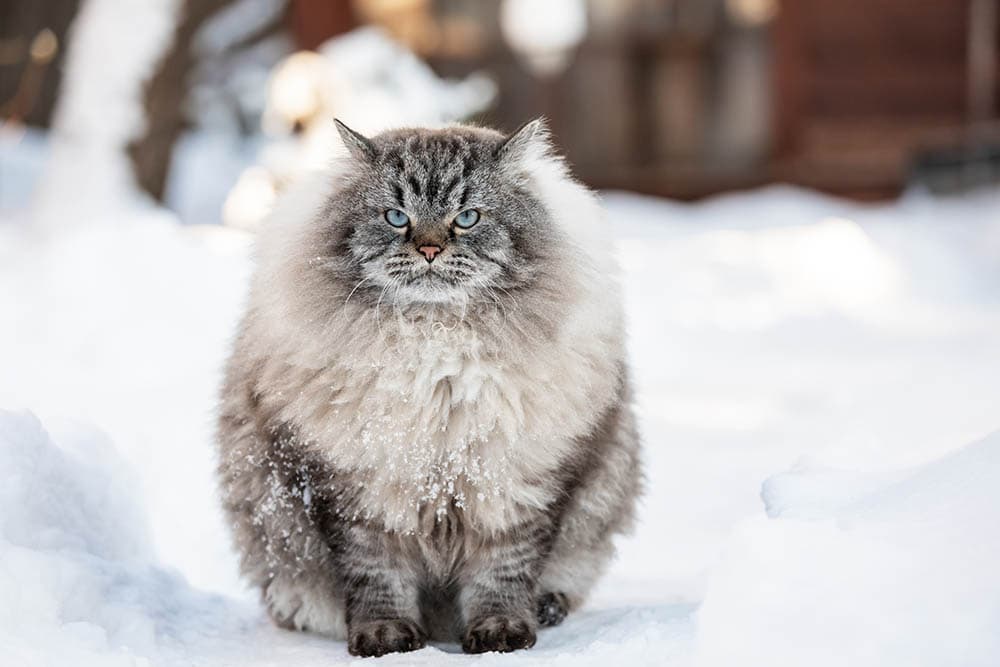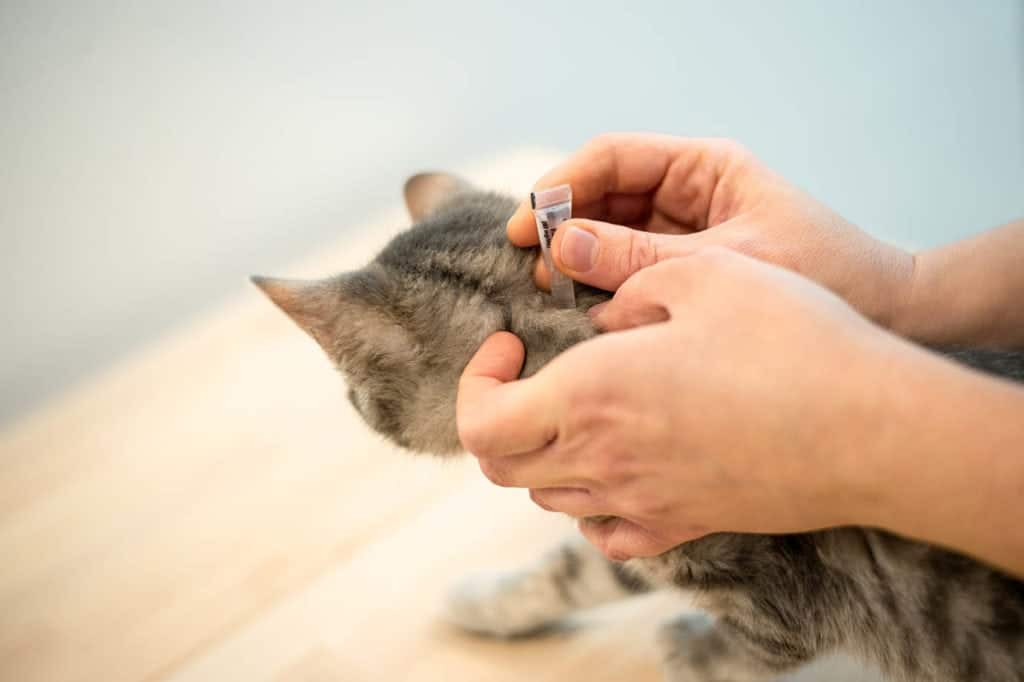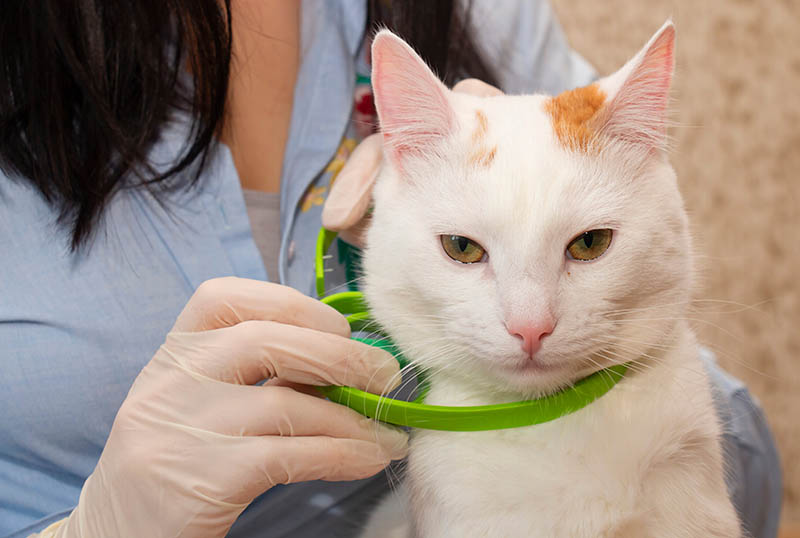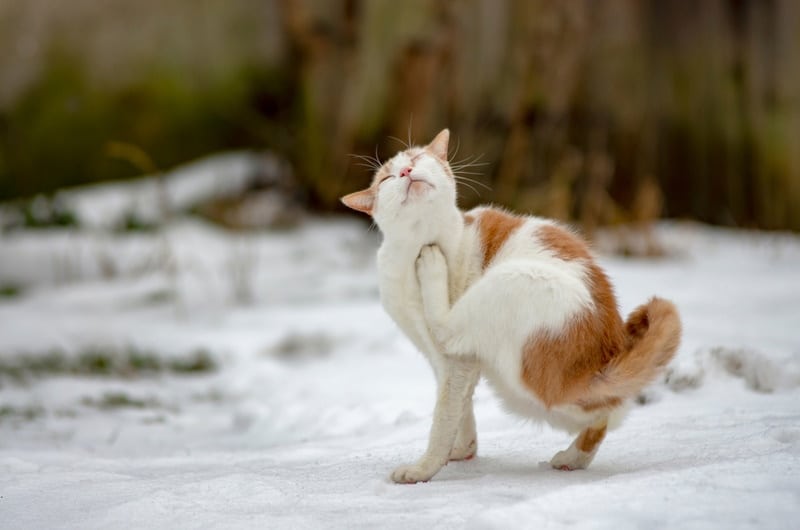No flea life stage can live in cold weather below 30°F for more than 5 days, which leads to the common misconception that your cat can’t get fleas during the winter1. While your cat has less of a chance of getting fleas during the winter, it’s certainly not impossible.
The problem is that all it takes is one flea, and if your cat is near another cat while they’re outside, the fleas can easily jump on them. Fleas prefer a specific temperature and humidity level to thrive. While they may slow down their life cycle during the winter when they’re outside, they remain active indoors throughout the entire year.
If an adult flea bites your cat, it will undoubtedly cause itching and discomfort. However, in addition to this, fleas can transmit diseases to your cat2. Fleas can carry tapeworm larvae and bacteria such as Bartonella, Rickettsia, and Wolbachia.
Fleas and the Winter
While most people only think about their cat getting fleas during the warmer months, it’s still possible for them to get fleas in winter! Although fleas slow down their life cycle during the winter months, they don’t die.
If your cat has fleas, they’ll likely become active when your cat is indoors since fleas love warm temperatures! So, even while fleas may not be as prolific when they are outside, they’ll remain active year-round if there are fleas inside your home.

How Do You Know If Your Cat Has Fleas?
Because cats are fastidious groomers and fleas are extremely good at hiding, sometimes it can be challenging to determine if your cat has fleas. Often, one of the first signs you’ll see if your cat is dealing with a flea infestation is an uptick in how much they scratch themselves.
Flea bites leave behind hard, red spots that you might be able to spot. From there, you can use a flea comb to pick up any flea dirt or, less likely, any of the fleas to confirm the infestation.
Finally, while fleas are notoriously difficult to spot and move quickly, sometimes you can see them as you pet your cat or move their hair around a bit. If you see fleas running around on your cat, it’s a clear sign of an infestation, and there are likely several more you need to worry about.
 Top 4 Tips for Getting Rid of Fleas
Top 4 Tips for Getting Rid of Fleas
If your cat has fleas, you want to get rid of them fast. But to do that, you need to know what you’re doing. That’s why we highlighted precisely what you must do to get all the fleas off your cat as quickly as possible.
1. Clean EVERYTHING
Fleas jump, crawl, and love to hang out in different places. You’ll need to clean the whole house, not only where your cat hangs out. That includes washing bedding, blankets, and sofa covers and thoroughly vacuuming and sweeping floors, carpeted areas, and along the edges of walls. If you miss a few areas and there’s a flea hanging out there, that’s all it’ll take to restart the infestation.
2. Treat Your Cat
A few flea treatment options are available commercially, but we recommend talking to your vet to get a prescription for your cat. If your cat enjoys baths, you can start by giving them a flea bath. This bath uses a shampoo that actively fights and kills adult fleas. Follow the directions on the shampoo, and give it plenty of time to soak in and find and kill all the fleas before washing it off.
Next, use a product that will kill all four flea life stages (egg, larva, pupa, and adult). You can choose a topical flea treatment that you apply directly to their fur, a collar, or a tablet. It’s essential to follow the instructions carefully. For example, topical treatments must be applied a couple of days before or after the bath to avoid washing off.
If you have more than one furry friend at home but only find fleas on one of them, that does not mean they are the only ones getting bitten. You must treat all your pets; otherwise, the infestation will persist.

3. Treat Your House
As well as cleaning, washing, and vacuuming your home, you may need to use a special home flea spray. The spray stops the development of flea eggs and larvae and kills adult fleas in hard-to-reach areas, such as cracks in the floor, skirting boards, and furniture.
Use a flea spray in every room after vacuuming, and take the time to do this well. Ensure you follow the instructions on the packaging about the dosage and frequency, and keep your pet and family away while it works.
4. Keep Up With Prevention
If you’re constantly treating adult fleas but never trying to prevent them, you’re going to end up fighting a never-ending battle. You need to treat adult fleas to kill the current ones, but you also need to use preventative flea (and tick) control to keep them from returning. Products with insect development inhibitors can help prevent immature fleas from maturing or reproducing.

Final Thoughts
While fleas prefer warm temperatures, it is certainly possible for a cat to get fleas all year round. Moreover, fleas are not just pesky parasites that can make you and your cat itch; they also transmit diseases. So, take all necessary steps and precautions to keep your cat from getting fleas. All it takes is one flea to turn into an infestation that can be challenging to get rid of!
Featured Image Credit: Morgentau , Shutterstock



 Top 4 Tips for Getting Rid of Fleas
Top 4 Tips for Getting Rid of Fleas







